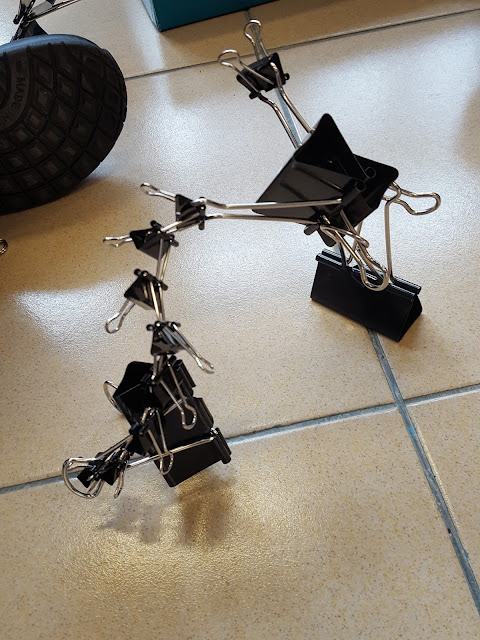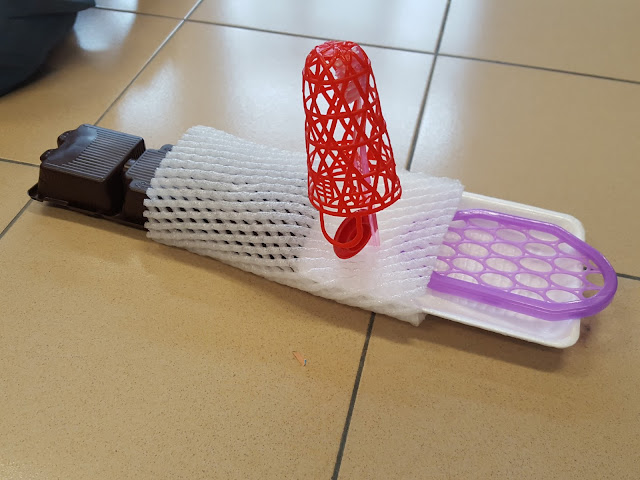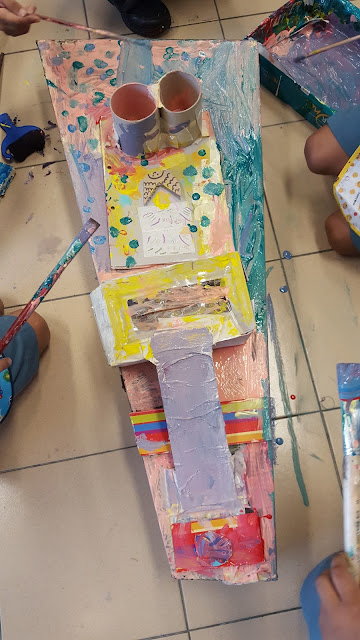The cardboard egg tray is perfect for holding paint, especially acrylic paint. The children would throw them away by the end of the class to minimise washing time and make more time for learning and making. Here's a video showing how to prepare them for use:
Tabs under construction!
Showing posts with label cardboard. Show all posts
Showing posts with label cardboard. Show all posts
Sunday, April 28, 2019
Tuesday, July 3, 2018
Housekeeping: Managing Paint
I'm very lucky to get two stainless stain sinks in each artroom with this depth! Perhaps they would remind you of a surgical sink, but in fact, it is quite common in art schools. This sink facilitates washing effectively and the most important thing is that it acts like a backsplash which otherwise would result in slippery floor. Imagine forty children doing washing and if one causes a little splash, it would be a significant amount of water on the ground towards the end of the lesson. With back to back classes, it is a substantial mental load just to ensure everyone's safety.
Another thing that I like doing is to minimise the amount of paint staining our new sink. I like children to clean their dirty paintbrushes on a recycled cardboard first before they do the washing. A picture says a thousand words:
Labels:
cardboard,
housekeeping,
painting,
sink
Thursday, January 25, 2018
Art class: Finding Balance
We were into our third week of a new school term and after meeting all 5 classes of 7 years old, I have finally met my youngest "revolt" in art class. It was during the end of art lesson and the children had to line up to return to their form class. A girl pull a long face and approached me, looking slightly distressed. She mumbled a one-word syllabus under her breath which sounds like "Ar...ar...". Finally, she exclaimed, sounding frustrated "Why don't we have Art lesson yet?" I couldn't contain my laughter and told her we had just finished one. In her exact words, she replied: "That's not Art. That's a game".
The child's comment is a great reminder for me to explore breath and depth in lesson planning as contemporary artists do work with materials, methods, conepts and subjects that challenge traditional boundaries.
In these lessons, the children worked in groups to make an artwork that show "balance" with an emphasis for teamwork and collaborative skills. They used some PE equipment, binder clips, cardboards, styroform peanuts and toothpicks, and plastic packagings.
The child's comment is a great reminder for me to explore breath and depth in lesson planning as contemporary artists do work with materials, methods, conepts and subjects that challenge traditional boundaries.
In these lessons, the children worked in groups to make an artwork that show "balance" with an emphasis for teamwork and collaborative skills. They used some PE equipment, binder clips, cardboards, styroform peanuts and toothpicks, and plastic packagings.
Labels:
artclass,
balance,
binderclips,
cardboard,
PEequipment,
plastics,
primaryone,
sculpture,
styroformpeanuts
Monday, April 3, 2017
Art Class: Building Spaces (Part III)
When you were looking at the prototypes/ artwork that the children were making, has the thought of them wasting materials ever crossed your mind? By viewing them as "wasteful", "inefficient" or "redundant" may be a symptom of a culture focused on efficiency over innovation (Brown, 2009). There is so much in life that pushes us to move fast. Sometimes, a peeve of mine is asking the children to walk faster or move faster so that we can get more things done within that hour of lesson. In our culture, speed is of the essence. Our quality of learning is judged by the speed of knowledge acquisition. You're a fast learner is considered a compliment as opposed to You're a slow learner.
The arts is about savouring, or being immersed in an experience that seemed timeless and spaceless. A lot of time in school is spend on discursive language or quantitative forms, while these skills are of crucial importance, it does not encompass all of what humans know or how they make meaning.
Last week is my first time organising 30 seven years old for painting class. I found out through a quick survey that a handful of them had never paint before. I was mentally prepared for the mess and as though it wasn't enough, on days when I have painting class with my youngest students, I needed to ensure that I start the class with a full stomach to keep up with all the energetic bodies!
Prior to the painting class, the children did mark making with their oil pastels. I also got them to write their names on every single stick of the oil pastels as I can't imagine having to deal with complaints of missing sticks in the future. Some of them tried to justify themselves by saying that their oil pastels is 'different' (brand) from others but it's just a plain no from me.
I use recycled paper to wrap a cardboard box as a paint container so that the children can dip their foam rollers and paintbrushes easily. They were quite fascinated by how different colours mixed together to produce a new colour. When the children ask for another colour, I will just "clean" the box with an A5-size recycled paper so that the new addition of paint will not be contaminated by the previous colour. At the end of the lesson, the children will wash their brushes and place all of them in a grey container beside the sink. With this lesson, I will be able to introduce basic colour theory and discuss about textures in art.
Labels:
artclass,
building,
cardboard,
painting,
primaryone,
recycled materials
Tuesday, March 7, 2017
Art Class: Building Spaces (Part II)
Part 1 of this post is here if you've missed it.
After the children started to use masking tape to attach the cardboard. I've also showed them 4 different ways of cutting and joining cardboard. The samples are secured onto the wall so that they can use them as reference. It's also important to make them see that we have to begin with the end in mind. For example, I've explained to them that we are not using clear tape because it'll be harder for the paint to stay. Ever since I muttered the word paint, some kids were asking me ARE WE PAINTING TODAY? at every lesson until we actually start painting...
 |
| I have other boys who followed him and started inserting the smaller toilet paper tubes into the big ones to make bullets. |

 |
| "It's a tank" |
 |
| A secret entrance to the house |
 |
| "This is how the elevator moves" |
 |
| "Flying House" |
 |
| "A special way of locking the bigger rolls by inserting the smaller ones inside" |
I was really glad that I did suspend judgements about how things are supposed to be and asked for an explanation. He started to show me excitedly about his discovery being able to act as a locking mechanism and I knew that I would never have thought of this. And this was done during the times when the children were not given any adhesive yet. Thus, this encounter reinforces the idea that children are able to think for themselves when given the appropriate tools and opportunities to support their growth.
At this point, I would say my favourite question of the day was from a girl who asked me: Ms Huang, when are you going to start teaching us real art? HA!
Labels:
artclass,
building,
cardboard,
primaryone,
recycled materials,
spaces
Sunday, February 19, 2017
Art Class: Building Spaces (Part I)
The Primary Ones children were given a theme on Space for their artwork this semester. At 7 years old, learning to work well together would definitely be a more important skill than learning what the primary/ secondary colours are.
To begin the unit, the children played Space game - making enclosed space with their bodies. The more adventurous children would try to explore making space with multiple planes (see the boy at the bottom left making a bridge) rather than just standing up and flexing their arms. Each time I beat my drum, they would have to change the kind of space that they have made. This would encourage them to think on their feet (quite literally!) as the speed of their next move would depend on my drum rhythm.
Next, to allow more time for them to incubate their ideas, the children played with different kinds of recycled cardboard (toilet paper rolls, tissue boxes etc) without adhesive first. I usually stopped my lesson 15 min in advance so that I can have a debrief session to talk about their problems when doing group work.
Teamwork is just as important as literacy. Once they have mastered teamwork skills, there'll be nothing they can't do in art class. Wasting some time in the beginning to gain more time in the end should be okay. These children have limited opportunities to work in groups as they have just started primary school this year and are just getting to know their friends. I really had to slow down my lessons to ensure that I spend more time talking to them about the important of relationship management. Groups that worked well together would be asked to share their "secrets" in front of the class. The children have no qualms about speaking in front of their classmates! They are sure better speakers than their art teacher when she was 7! I'm maintaining my class routines and hopefully they will be better listeners in the weeks to come.
To begin the unit, the children played Space game - making enclosed space with their bodies. The more adventurous children would try to explore making space with multiple planes (see the boy at the bottom left making a bridge) rather than just standing up and flexing their arms. Each time I beat my drum, they would have to change the kind of space that they have made. This would encourage them to think on their feet (quite literally!) as the speed of their next move would depend on my drum rhythm.
Next, to allow more time for them to incubate their ideas, the children played with different kinds of recycled cardboard (toilet paper rolls, tissue boxes etc) without adhesive first. I usually stopped my lesson 15 min in advance so that I can have a debrief session to talk about their problems when doing group work.
Teamwork is just as important as literacy. Once they have mastered teamwork skills, there'll be nothing they can't do in art class. Wasting some time in the beginning to gain more time in the end should be okay. These children have limited opportunities to work in groups as they have just started primary school this year and are just getting to know their friends. I really had to slow down my lessons to ensure that I spend more time talking to them about the important of relationship management. Groups that worked well together would be asked to share their "secrets" in front of the class. The children have no qualms about speaking in front of their classmates! They are sure better speakers than their art teacher when she was 7! I'm maintaining my class routines and hopefully they will be better listeners in the weeks to come.
After which, the children were tasked to brainstorm on the theme of Space. Some children were very knowledgeable, they could talk about black holes and milky way! If you've noticed, this particular art room has chairs or tables removed to create a space where children are not destined to become table artists. I'm looking forward to observe how the children would have progress in the subsequent weeks.
Labels:
artclass,
building,
cardboard,
primaryone,
recycled materials,
spaces
Subscribe to:
Comments (Atom)







































